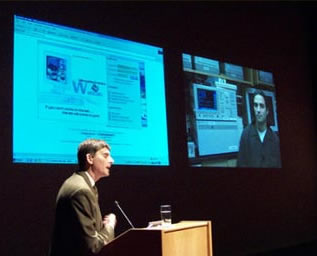Kenya: Optic Fibre Cable Impacting Positively on Education
David Otwoma, managed to complete do his Kenya Certificate Secondary Examination (KCSE) through the helping hand of well wishers. Though he scored a C + (plus), which is the minimum university entry grade his chances of proceeding to university were minimal.
He thus settled in his rural home, making a living through small scale farming and poultry keeping. But, with the installation of electricity in the nearby market centre through rural electrification initiative, one of the Information Communication Technology (ICT) graduates opened an internet cyber cafe in the market.
With his humble savings in the bank he enrolled for an online distance learning degree programme for the convenience and the affordable school fees that were charged. Though Otwoma took a little bit longer to complete his degree in business studies – he stands tall in the village as a testimony of resilience and the magic of e-learning.
Two years ago, before the arrival and penetration of optical fibre cable in Kenya to its major towns and the interior parts of the country, harnessing internet by satellite services was expensive and limited in capacity beyond the reach of most educational institutions, says Regional Sales Manager, Seacom Ltd, Jacquiline Mwai .
The arrival of the submarine optical fibre cable ushered in higher broadband capacity, increased bandwidth and improved connectivity for educational institutions.
This has facilitated Kenya to tap into National Research and Educational Network (ENRENs) whose “services make it easier to provide instruction to remote learners, collaborate with geographically-dispersed colleagues, and tap the expertise of a wide range of contacts,” says the Connectivity Africa External Review Report.
ENRENs enhances access to specialized research instruments such as telescopes, applications such as medical imaging, and databases such as satellite data.
Mwai says the company is offering educational and research services to 75 institution countrywide. Providing them with a learning platform with voice, data and video capacity and a wireless campus network.
The optic fibre cable has oiled interactive learning and access to online teaching facilities, Mwai says, in Kenya and within the East Africa region, where Education Roam Network (ED-ROAM Network) is widening access to e-learning with an improved virtual mobility of both the students and lectures optimizing time and content sharing.
Through e-learning Kenyans are able to access developed centres for research material databases thus scaling the quality of research and teaching locally.
Internet – Laboratories (i-Lab) are now a reality in Kenya. Hence part of the trials with Massachusetts Institute of Technology (MIT) team are leading to excellence in engineering in the country.
This is spurring Kenya to become a Pan-Africa centre of excellence – an opportunity for it to scale higher in global inventions and discovery.
The Seacom Regional Sales Manager points out that through the optical fibre cable Kenyans are having an opportunity to turn their ideas into money through innovations – thus the number of information ICT entrepreneurs is growing in and beyond institutions of learning.
This is giving birth to the emergence of i-Hub concepts, creating ICT gurus, software development and exposure to the global ICT market. Through the access and availability of the high speed bandwidth ICT incubation centres are blossoming in the country.
By embracing this internet super highway, the development of a highly skilled and dynamic global workforce is now a reality. Lectures in Kenyan institutions of learning will widen their income earning opportunities as they can teach online alongside being worldwide authorities.
The optic fibre cable has launched a fully fledged e-commerce industry in the education sector through e-books and e-libraries, bringing down the prices of books. This has made global virtual learning centres of excellence a reality.
The Minister of Finance’s budget allocated Sh 44.2 billion for ICT with the aim of improving internet penetration from 9 percent to greater heights. The government’s initiative to plant digital villages across the country, tapping into the optic fibre cable will scale opportunities for e-learning and e-commerce in terms of costs and convenience, for many Otwomas to benefit.
![]() Posted by Robert Okemwa Onsare
on Tue, 14 Jun 2011 10:15:17. Filed under Education.
You can follow any responses to this entry through the RSS 2.0.
You can leave a response or trackback to this entry
Posted by Robert Okemwa Onsare
on Tue, 14 Jun 2011 10:15:17. Filed under Education.
You can follow any responses to this entry through the RSS 2.0.
You can leave a response or trackback to this entry
About Robert Okemwa Onsare
Robert Onsare studied Electronic Technology at the University of Eastern Africa, Baraton. Currently Mr Onsare is an incubation student at the University of Nairobi, School of Engineering, FabLab, a venture project of the university and Massachusetts Institute of Technology (MIT). He is a member of the African Technology Policy Studies Network (ATPS) and a published poet. Mr Onsare is based in Nairobi, Kenya.
Click Here to Subscribe to Robert Okemwa Onsare items published in The Global Herald by RSS.
Article Tags
This article is tagged with the following News Tags: Broadband, E-learning, Fibre Optic, Internet, Kenya, Seacom.









The introduction of optical fiber systems through Kenya and the rest of Africa represents a gigantic opportunity for education. Through the internet, educators, students and adults can access amazing educational resources such as iLabs that are available around the world. Even more exciting is the opportunity to become a contributor to the global pool of knowledge which wide spread access to connectivity makes possible. We are looking forward to accessing iLabs created in Africa to satisfy unique local educational needs becoming available to the rest of the world. It is wonderful to see that entrepreneurs are jumping in and are identifying business opportunities in this emerging market. Hopefully, this will speed up the widespread reach of optical fiber connectivity.